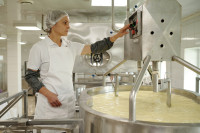Large dairies can use whey to produce biogas and then sell the resulting liquid digestate, once dried, as an organic granular fertiliser. This way, a by-product becomes a source of energy and subsequently an additional revenue stream.
Whey provides energy – and not just as a drink!
In 2023, European dairies received almost 150 million tonnes of raw milk; around 70 per cent of this was processed into cheese and butter. This generates vast quantities of whey: according to the EU, European dairies produced just over 52 million tonnes in 2023 alone.
Whey can be sold, for example, as a drink, as whey powder or as animal feed. However, with fossil fuel prices on the rise, large dairies in particular are finding it increasingly attractive to produce biogas from whey.
The calculation is straightforward: dairies already have whey in large quantities, so it is a free raw material they can use to generate their own biogas.
They can then use this biogas to produce electricity and heat on-site, thereby reducing their energy costs and becoming less dependent on rising gas and oil prices.
Alternatively, dairies can upgrade the biogas and feed it into the natural gas grid, receiving payment for the injection. From 2027, when gas and oil prices are set to rise under the second phase of the EU Emissions Trading Scheme, demand for biogas could increase, making grid injection economically more attractive.
Problem: What to do with the liquid digestate?
When whey is used to produce biogas, it yields liquid digestate containing virtually no solids. In small biogas plants, spreading this digestate on nearby fields is usually no problem. However, large dairies with correspondingly sizeable biogas installations face a challenge: they must first store vast quantities of liquid digestate and then transport it to distant fields. Both storage and long-haul transport involve considerable effort and cost.
Drying liquid digestate pays off, especially in large volumes
For large volumes of liquid digestate, drying is the sensible option. In collaboration with Arnold + Partner, SWISS COMBI has developed a process to turn liquid digestate into a stable, spreadable fertiliser granulate.
The ecoFertiliser Plant (eFP) combines Arnold + Partner’s vacuum evaporator with our proven ecoDry drum dryer. First, the liquid feedstock is concentrated via vacuum evaporation into a viscous syrup, which is then processed in the ecoDry into granulate — all achieved with impressive energy efficiency.
Drying with high energy efficiency thanks to heat recovery
In the eFP, around 28 tonnes of liquid digestate are converted into approximately 2.6 tonnes of fertiliser granulate every hour! The heat demand is under 300 kW per tonne of water evaporated, making the system far more efficient than conventional drying methods, which often require more than three times that energy.
This exceptional efficiency is achieved through two key factors: firstly, the energy-optimised design of the vacuum evaporator and ecoDry dryer; and secondly, a sophisticated heat-recovery system. The waste heat generated in the ecoDry is utilised in the vacuum evaporator – an intelligent interaction between the components.
Moreover, the hot water produced during evaporation can be reused, for instance, for heating digestion tanks or buildings.
Why drying digestate pays off
Drying liquid digestate offers several economic and environmental benefits:
Rather than bearing the cost of spreading liquid digestate, the granulated end product can be sold as organic fertiliser – an attractive additional revenue stream.
The compact granulate is easy to store and, due to its significantly reduced volume, saves on storage and transport capacity.
Spreading liquid digestate generates nitrous oxide, a potent greenhouse gas. This effect is eliminated by using the dried granulate. Furthermore, reduced transport requirements lower CO₂ emissions, positively impacting the greenhouse-gas balance and potentially qualifying for savings or grants under climate-protection programmes.
If you’d like to learn more about how the ecoFertiliser Plant can be applied in dairies, please don’t hesitate to contact us!

